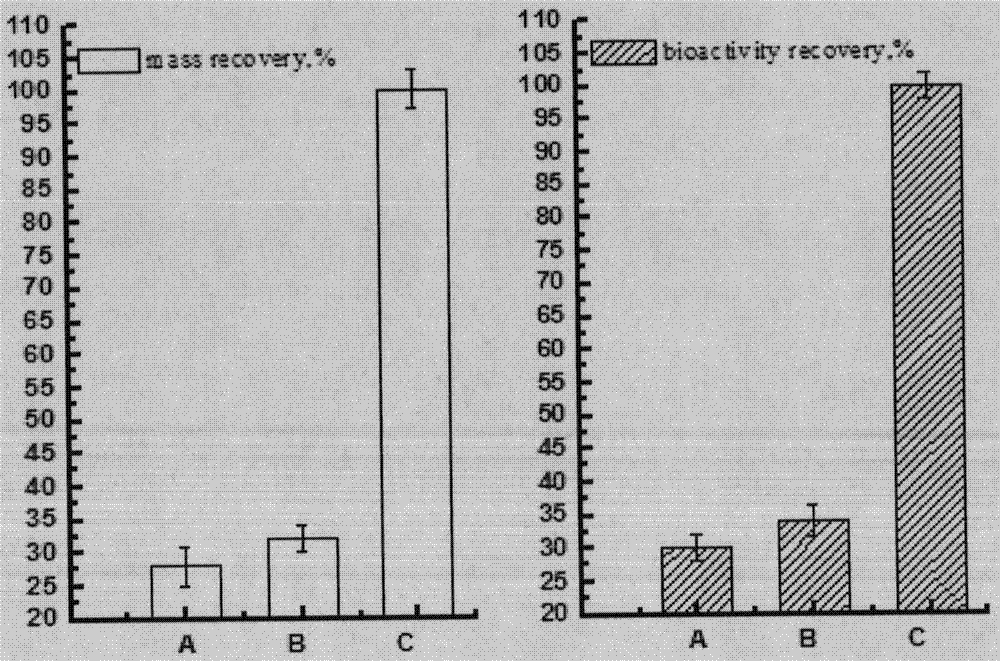Protein product reuse method
A protein and product technology, which is applied in the field of protein product reuse, can solve the problems that the refolding process cannot restore the activity of recycling, reduce the degradation of protein chains, and the promotion effect is limited, so as to increase the number of reuse, simplify the process, increase the concentration and The effect on success rate
- Summary
- Abstract
- Description
- Claims
- Application Information
AI Technical Summary
Problems solved by technology
Method used
Image
Examples
Embodiment 1
[0038] Cultivation, refolding and purification of recombinant bacteria:
[0039] Strains were stored at -80°C. Scrape the surface of the frozen glycerol tube with a sterilized inoculation needle, then immediately scratch the bacteria adhering to the inoculation needle on the surface of the LB agar plate containing 100 μg / ml Amp, and incubate overnight at 37°C. Pick a single colony and inoculate them in three 500ml shake flasks containing 100ml LB culture medium respectively, culture at 37°C, shaker 240rpm, and transfer to 3L liquid LB medium when the measured OD600 reaches 1.0 (add 100μ / ml Amp ), cultivated under the same conditions, and when OD600 reached 1.0, it was transferred to a 100L fermenter as a secondary seed liquid. Ferment at 37°C, adjust rotation speed and ventilation during fermentation to keep oxygen saturation at 20%-60%, induce with 1mM IPTG when OD600 is 1.0 to 2.0, keep oxygen saturation at 20%-60%, pH In 7.0-7.4, (ammonia and hydrochloric acid adjustment)...
Embodiment 2
[0043] PEG modification uses Mal-mPEG modifier for fixed-point modification, the molecular weight of Mal-mPEG modifier is 20KD, the modification conditions are: the buffer uses Tris-HCl, pH8.5, the molar ratio of modifier to composite interferon is 10:1, and the modified The temperature is 4 degrees, and the modification time is 6 hours.
[0044] Equilibrate the chromatographic column (about 5 column volumes) with loading buffer (50mM Tris-HCl, pH8.5), take the supernatant after filtering the modified sample and put it on the anion exchange column, and the linear flow rate of loading is 4ml / min . After loading the sample, rinse with loading buffer (50mM Tris-HCl, pH8.5) at a linear flow rate of 4ml / min until the absorption at 280nm returns to the baseline. The modified sample was purified from 0-100% gradient with elution buffer (50mM Tris-HCl, 1M NaCl, pH8.5), the elution linear flow rate was 5ml / min, 10 column volumes were washed, and the elution peaks were collected respec...
Embodiment 3
[0046] According to the provisions of the Pharmacopoeia of the People's Republic of China (2005 Edition III), the activity and activity changes of the compound interferon and its PEG-modified products were detected at the cellular level by the cytopathic inhibition method. Principle: According to the effect that interferon can protect human amniotic cells (WISH) from vesicular stomatitis virus (VSV), the surviving human amniotic cells (WISH) were stained with crystal violet, and the absorbance was measured at a wavelength of 570nm. The protective effect curve of interferon on human amniotic cells (WISH) can be obtained, and the biological activity of interferon can be determined accordingly. When human amnion cells (WISH) are attacked by VSV virus, the reciprocal of the interferon dilution that can protect half of the cells from being attacked is 1 activity unit. Detect the initial value before denaturation-refolding operation, and the compound interferon activity is 5.44×10 ...
PUM
 Login to View More
Login to View More Abstract
Description
Claims
Application Information
 Login to View More
Login to View More - R&D
- Intellectual Property
- Life Sciences
- Materials
- Tech Scout
- Unparalleled Data Quality
- Higher Quality Content
- 60% Fewer Hallucinations
Browse by: Latest US Patents, China's latest patents, Technical Efficacy Thesaurus, Application Domain, Technology Topic, Popular Technical Reports.
© 2025 PatSnap. All rights reserved.Legal|Privacy policy|Modern Slavery Act Transparency Statement|Sitemap|About US| Contact US: help@patsnap.com



